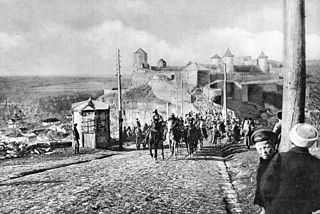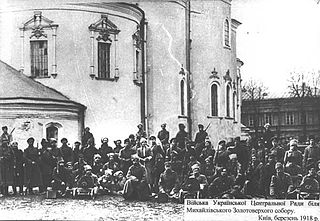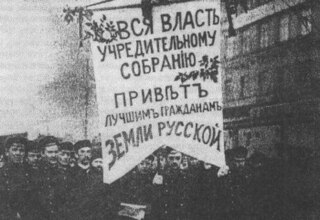
The Russian Civil War was a multi-party civil war in the former Russian Empire sparked by the overthrowing of the social-democratic Russian Provisional Government in the October Revolution, as many factions vied to determine Russia's political future. It resulted in the formation of the Russian Socialist Federative Soviet Republic and later the Soviet Union in most of its territory. Its finale marked the end of the Russian Revolution, which was one of the key events of the 20th century.

The Treaty of Brest-Litovsk was a separate peace treaty signed on 3 March 1918 between Soviet Russia and the Central Powers, by which Russia withdrew from World War I. The treaty, which followed months of negotiations after the armistice on the Eastern Front in December 1917, was signed at Brest-Litovsk.

The Declaration of the Rights of the Peoples of Russia was a document promulgated by the Bolshevik government of Russia on 15 November 1917 and signed by Vladimir Lenin and Joseph Stalin.

The Soviet westward offensive of 1918–1919 was part of the campaign by Soviet Russia into areas abandoned by the Ober Ost garrisons that were being withdrawn to Germany following that country's defeat in World War I. The initially successful offensive against the Republic of Estonia ignited the Estonian War of Independence which ended with the Soviet recognition of Estonia. Similarly, the campaigns against the Republic of Latvia and Republic of Lithuania ultimately failed, resulting in the Latvian–Soviet Peace Treaty and Soviet–Lithuanian Peace Treaty respectively. In Belarus, the Belarusian People's Republic was conquered and the Socialist Soviet Republic of Byelorussia proclaimed.

During the Polish–Soviet War of 1919–1921, Soviet Russia and its client state, Soviet Ukraine, were in combat with the re-established Second Polish Republic and the newly established Ukrainian People's Republic. Both sides aimed to secure territory in the often disputed areas of the Kresy, in the context of the fluidity of borders in Central and Eastern Europe in the aftermath of World War I and the breakdown of the Austrian, German, and Russian Empires. The first clashes between the two sides occurred in February 1919, but full-scale war did not break out until the following year. Especially at first, neither Soviet Russia, embroiled in the Russian Civil War, nor Poland, still in the early stages of state re-building, were in a position to formulate and pursue clear and consistent war aims.

The Supreme Commander of All German Forces in the East, also known by its German abbreviation as Ober Ost, was both a high-ranking position in the armed forces of the German Empire as well as the name given to the occupied territories on the German section of the Eastern Front of World War I, with the exception of Poland. It encompassed the former Russian governorates of Courland, Grodno, Vilna, Kovno and Suwałki. It was governed in succession by Paul von Hindenburg and Prince Leopold of Bavaria. It was abandoned after the end of World War I.

Various factions fought over Ukrainian territory after the collapse of the Russian Empire following the Russian Revolution of 1917 and after the First World War ended in 1918, resulting in the collapse of Austria-Hungary, which had ruled Ukrainian Galicia. The crumbling of the empires had a great effect on the Ukrainian nationalist movement, and in a short period of four years a number of Ukrainian governments sprang up. This period was characterized by optimism and by nation-building, as well as by chaos and civil war. Matters stabilized somewhat in 1921 with the territory of modern-day Ukraine divided between Soviet Ukraine and Poland, and with small ethnic-Ukrainian regions belonging to Czechoslovakia and to Romania.

The Ukrainian War of Independence, also referred to as the Ukrainian–Soviet War in Ukraine, lasted from March 1917 to November 1921. It saw the establishment and development of an independent Ukrainian republic, most of which was absorbed into the Ukrainian Soviet Socialist Republic between 1919 and 1920. The Ukrainian Soviet Socialist Republic was one of the constituent republics of the Soviet Union between 1922 and 1991.

The Treaty of Brest-Litovsk was signed on 9 February 1918 between the Ukrainian People's Republic (UPR) and the Central Powers, ending Ukraine's involvement in World War I and recognizing the UPR's sovereignty. The treaty, which followed the armistice on the Eastern Front in December 1917, was signed at Brest-Litovsk. The peace delegation from Soviet Russia, led by Leon Trotsky, did not recognize the UPR delegation, which had been sent from the Central Rada in Kiev, instead recognizing a delegation from the Ukrainian People's Republic of Soviets in Kharkov.

Estonia was under military occupation by the German Empire during the later stages of the First World War. On 11–21 October 1917, the Imperial German Army occupied the West Estonian archipelago, including the larger islands of Saaremaa (Ösel), Hiiumaa (Dagö), and Muhu (Moon).

The revolt of the Czechoslovak Legion comprised the armed actions of the Czechoslovak Legion in the Russian Civil War against Bolshevik authorities, beginning in May 1918 and persisting through evacuation of the Legion from Siberia to Europe in 1920. The revolt, occurring in Volga, Ural, and Siberia regions along the Trans-Siberian Railway, was a reaction to a threat initiated by the Bolsheviks partly as a consequence of the Treaty of Brest-Litovsk. One major secondary consequence of victories by the Legion over the Bolsheviks was to catalyze anti-Bolshevik activity in Siberia, particularly of the Committee of Members of the Constituent Assembly, and to provide a major boost for the anti-Bolshevik or White forces, likely protracting the Russian Civil War.

The Operation Faustschlag, also known as the Eleven Days' War, was a Central Powers offensive in World War I. It was the last major offensive on the Eastern Front.

The Revolutions of 1917–1923 were a revolutionary wave that included political unrest and armed revolts around the world inspired by the success of the Russian Revolution and the disorder created by the aftermath of World War I. The uprisings were mainly socialist or anti-colonial in nature. Some socialist revolts failed to create lasting socialist states. The revolutions had lasting effects in shaping the future European political landscape, with for example the collapse of the German Empire and the dissolution of Austria-Hungary.

The Ukrainian People's Republic (UPR) was a short-lived state in Eastern Europe. Prior to its proclamation, the Central Council of Ukraine was elected in March 1917 as a result of the February Revolution, and in June, it declared Ukrainian autonomy within Russia. Its autonomy was later recognized by the Russian Provisional Government. Following the October Revolution, the Central Council of Ukraine denounced the Bolshevik seizure of power and proclaimed the Ukrainian People's Republic with a territory including the area of approximately eight Russian imperial governorates. It formally declared its independence from Russia on 22 January 1918.

The Ukrainian–Soviet War is the term commonly used in post-Soviet Ukraine for the events taking place between 1917 and 1921, nowadays regarded essentially as a war between the Ukrainian People's Republic and the Bolsheviks. The war ensued soon after the October Revolution when Lenin dispatched Antonov's expeditionary group to Ukraine and Southern Russia.

On 15 December [O.S. 2 December] 1917, an armistice was signed between the Russian Republic led by the Bolsheviks on the one side, and the Austro-Hungarian Empire, the Kingdom of Bulgaria, the German Empire and the Ottoman Empire—the Central Powers—on the other. The armistice took effect two days later, on 17 December [O.S. 4 December]. By this agreement Russia de facto exited World War I, although fighting would briefly resume before the Treaty of Brest-Litovsk was signed on 3 March 1918, and Russia made peace.

Events from the year 1918 in Russia
The Treaty of Peace between Finland and Germany, also called the Berlin Peace Treaty, signed in Berlin on 7 March 1918 ended the state of war that existed between Finland and the German Empire as a result of World War I. It paved the way for German intervention in the Finnish Civil War and the invasion of Åland.
Operation Schlußstein was a German military operation, which was carried out towards the end of the First World War in the Baltic Sea region and in Karelia with the aim of occupying the Murman Railway.
The Treaty of Berlin of August 27, 1918 was an agreement signed after several months of negotiations between Bolshevik representatives and the Central Powers, mainly represented by the Germans. This treaty completed and clarified the political and economic clauses of the Treaty of Brest-Litovsk, which had been left out of the winter 1917-1918 negotiations. The latter were aimed at ending the war between the Central Powers and Russia and clarifying the extent of Russia's territorial losses, but left unresolved the question of war indemnities due to the Imperial Reich and its allies. Similarly, the nature of the new economic relations between the Central Powers and Russia was not discussed in depth at Brest-Litovsk. Consequently, in accordance with the terms of the peace treaty signed in early 1918, negotiations should regulate future economic relations between the Central Powers and Bolshevik Russia, and lead to the conclusion of an agreement between the Reich and its allies, on the one hand, and Russia, on the other. However, due to the rapid development of the conflict during September and October 1918, the provisions contained in the text of this treaty never came into force. Nevertheless, this agreement laid the foundations for the Treaty of Rapallo between the Reich and Bolshevik Russia, which came into force in 1922.
















